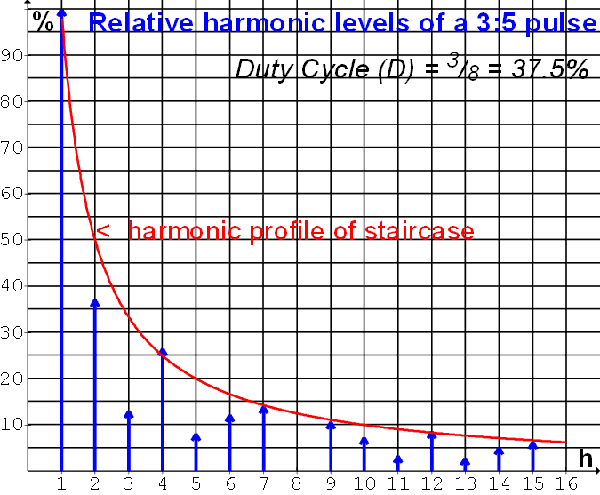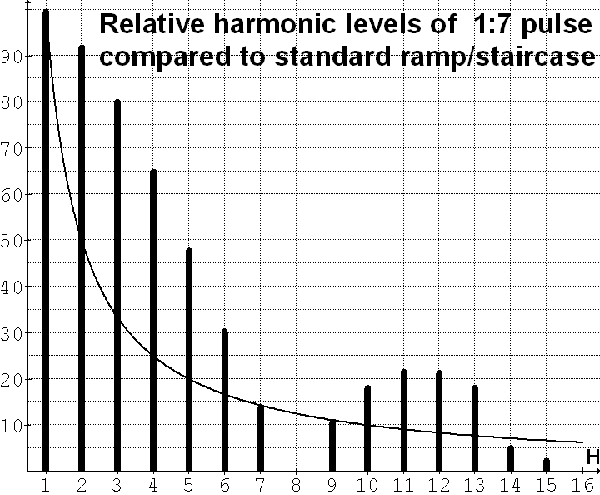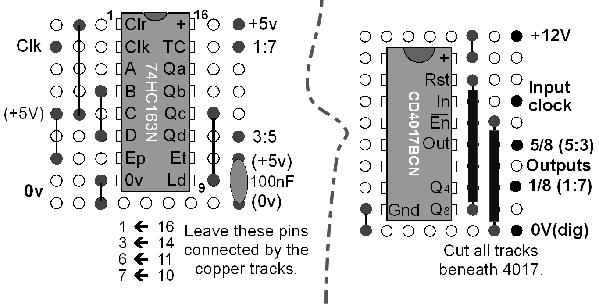| Author |
Message |
Tony Deff
Joined: May 25, 2008
Posts: 51
Location: Suffolk, UK
|
 Posted: Sun Mar 22, 2009 1:41 pm Post subject: Posted: Sun Mar 22, 2009 1:41 pm Post subject:
 New Tone-Flavour! New Tone-Flavour!
Subject description: Even harmonics from simple asymmetric divide-by-8 |
  |
|
We all know that synthesisers have "flangers" that sweep-through the gamut of pulse duty-cycles, thereby constantly changing the harmonic spectrum and so producing a "whoosh" of tone-colour, so the "new flavour" applies here only to electronic pianos and organs. These instruments operate with a limited number of waveforms: usually basic square-waves, added together and/or filtered. This leads to a boring sameness of voices — after all, you cannot modify with tone-filters what you don't have in the first place!
Rectangular-wave (i.e. non-square) generators are not difficult or new — most of the old Top-Octave chips had variants which produced 60%. Trouble was, as soon as you divided-by-two to get the octave below, you lost the even harmonics. These days, with synchronous counters instead of ripple counters, we have the technology!
A 3:5 mark-space ratio (37.5% duty-cycle) has significant amounts of even harmonics. Compared to an 8-level staircase, the 3rd and 5th are reduced, such that the 4th is greater than the 3rd and the 6th is greater than the 5th. (Neither waveform includes the 8th or 16th)
[Edit: 25 March adds harmonic spectrum graph for Duty-Cycle 37.5%.]
This promises a good contrast with existing voices, in which the third harmonic is usually ubiquitous (being the most difficult to filter).
What does it sound like?
You tell me what an orange tastes like, and I'll tell you what this sounds like! 
Actually, I'm bluffing; I am unable to produce and test it because of poor health. It doesn't stop me dreaming though, and here are a couple of suggested means to generate both the 37.5% and a 12.5% duty-cycle.
Anyone care to be a public hero and test one, then attempt to tell the rest of us what it might be used to simulate?
The 74HC161N/74HC163N circuit is very simple to build — but perhaps not to understand! The unbroken tracks under the chip (as indicated) are essential to its operation, which is deliberately not explained here because this under-used and under-rated chip needs to be studied and appreciated more. (If there is any demand, I'll post other circuits for this chip).
12Volt compatible 40161/163 are hard to find and expensive. For 12V operation, the 4017 circuit will be preferred, especially as the device is already more frequently used by amateurs. Its operation is more straightforward, but again not explained as it takes all the fun out of it!
[Note that the 4017 produces a 5:3 mark-space ratio (62.5% duty-cycle) but this is acoustically identical to a 3:5 mark-space ratio, being merely voltage inversion]
Incredibly, the 12.5% outputs (1:7) have the same even harmonics as the 37.5%, in absolute terms. However, because the fundamental is considerably reduced, the pulse will generally be amplified (i.e. not be attenuated as much) to match the conceived power levels of other waveforms, so that the result is a spread of many harmonics of more equal power. It is said of narrow pulses that they have a "nasal" quality, suitable for an oboe. A 1:7 pulse has been tried by a member of The Electronic Organ Constructors Society* http://www.eocs.org.uk/ and claimed it has something approaching a trumpet sound.
(A trumpet spectrum I have seen has a dominant 2nd, with near-equal 1st, 3rd and 4th).
(*They admitted Tone-Deaf, so they may even let you join!)
These circuits are basically divide-by-8s, and so are octave-compatible with 8-level staircases (i.e. 3 added square-waves).
Homework: After studying the '163 and '4017 to see how it all works, how would you use the '4022 to achieve the same end?
What further developments does this approach lead to (which can also be implemented with the 4017)?
[Edit: 8 April circuit connections clarified. Harmonic spectrum graph for Duty-Cycle 12.5% added.]
| Description: |
Harmonic Spectrum of 3:5 (or 5:3) Rectangular wave, compared to staircase.
Attenuation has been adjusted so that fundamental level matches that of staircase. |
|
| Filesize: |
19.26 KB |
| Viewed: |
282 Time(s) |
| This image has been reduced to fit the page. Click on it to enlarge. |

|
| Description: |
| Attenuation has been adjusted so that fundamental level matches that of staircase. |
|
| Filesize: |
12.67 KB |
| Viewed: |
274 Time(s) |
| This image has been reduced to fit the page. Click on it to enlarge. |

|
| Description: |
| These two single-chip generators provide identical harmonic spectra (if voltage levels equalized) |
|
| Filesize: |
61.84 KB |
| Viewed: |
305 Time(s) |
| This image has been reduced to fit the page. Click on it to enlarge. |

|
Last edited by Tony Deff on Wed Apr 08, 2009 2:17 pm; edited 3 times in total |
|
|
Back to top
|
|
 |
loss1234

Joined: Jul 24, 2007
Posts: 1536
Location: nyc
Audio files: 41
|
|
|
Back to top
|
|
 |
loss1234

Joined: Jul 24, 2007
Posts: 1536
Location: nyc
Audio files: 41
|
|
|
Back to top
|
|
 |
Tony Deff
Joined: May 25, 2008
Posts: 51
Location: Suffolk, UK
|
 Posted: Mon Apr 06, 2009 8:00 am Post subject:
Rectangular-wave generator chips Posted: Mon Apr 06, 2009 8:00 am Post subject:
Rectangular-wave generator chips
Subject description: Chip types and connections |
  |
|
I apologize for not leaving enough space between the two separate (one-chip) circuits. I was trying to prevent too much display shrinkage, so maybe I'll re-up-load that. (Done)
You are correct in assuming that the inter-connecting tracks apply only to the left ('163) chip. All of the tracks under the 4017 need to be cut; pins 1-7 are (unused) outputs.
The chef who wrote the CMOS Cookbook should be made to eat his hat, but maybe his "get-out clause" is in saying "functionally" equivalent (without defining which function). In court, his attorney can say:
"Ah, but they are functionally equivalent when +5V is applied to pin 16 and Ground to pin 8 and both chips are dividing by 16".
I could point-out minor details of the 4526 having (unlike the '163) an asynchronous and active-high reset, an asynchronous and active-high load, different pin-numbers and the down-counting, but that's probably just me being "picky".
I have deleted the mis-leading line in my Cookbook (same goes for the claim that the 4522 is functionally equivalent to '160).
The count-sequence that makes the given '161/'163 circuit function as it does just does not compute for a down-count. The 74LS169 (up/down counter) will also work, if pins 7 & 10 are tied low. (Pin 15 will then be ratio 7:8, which makes no acoustic difference). There appears to be no 'HC169, but there is an equivalent 'HC669 (but it makes no economic sense to use).
I believe all '160/'162 (decade counters) will also work, however, because of the way they cycle-through "illegal" (non-decimal) counts 14 and 15.
You can sometimes pick up these items from surplus stores for a pittance.
http://www.bardwells.co.uk (/subcats.asp?catid=LS001 else use search code 74LS162) has these for 15 quaint British pennies (13, if you do not want to pay UK tax, but it's hardly worth the hassle, is it? I don't know what you do about the IRS, though — they are hardly likely to believe you are importing something that cheap!).
I did manage to try these some years back (when they were only 12 pence!) and can confirm they are Motorola devices which will cycle-through non-decimal counts 14 and 15. You can also get the 4022 at the same price, or the 4017 for a wickedly expensive 22p (19p without tax).
Since I've given everyone reading this a clue as to the circuit's operation, I may as well "spill the beans":
It functions by cutting-out 8 counts of the 16, synchronously jumping-over 3 counts in the first half-cycle (when Qd is low) and jumping-over 5 counts in the second half-cycle (when Qd is high).
It is a sort of State Machine with feedback. Such "jumps" cannot be executed by an asynchronous load, which is unco-ordinated and of uncertain timing.
Once it settles into a steady state (gone through state zero) the sequence is:
(DCBA)
>0000 (By pulling pin 9 low, Qc sets-up the IC for a re-load on the next rising clock-edge)
>0100 (Qc goes high because Data Input C was tied high, allowing the IC to resume incrementing. Qa, Qb and Qd re-load themselves LOW from feedback).
>0101 (after normal increment)
>0110 (after normal increment)
>0111 (after normal increment)
>1000 (Start of the MARK period from Qd, after normal increment. Qc sets-up the IC for another re-load on the next rising clock-edge).
>1110 (Qc HIGH allows the count to proceed again, as before. Qa gets re-loaded LOW from itself; Qd and Qb get re-loaded HIGH from Qd).
>1111 (after normal increment. Internal AND-gate sends pin 15 HIGH , creating the 1:7 output)
>0000 (normal 4-bit binary over-flow re-starts a new cycle with a SPACE period)
Note that Qa is always re-loaded as a LOW, and therefore input A could have been tied LOW. The link A-to-Qa is for pure constructional convenience.
If input C is tied low, the circuit gets well and truly stuck!!
Note also that Qd (normally though-of as a divided-by-16 output) can be used to drive a similar circuit 3 octaves lower, but that Qc (normally though-of as a divided-by-8 output) cannot be used to drive a similar circuit 2 octaves lower because of the irregular edges. To derive an octave-lower output, or n-octaves lower, the chip's Enables must be used (but that detail was going to wait until we hear how useful the sound is!)
Last edited by Tony Deff on Wed Apr 08, 2009 2:49 pm; edited 5 times in total |
|
|
Back to top
|
|
 |
blue hell
Site Admin

Joined: Apr 03, 2004
Posts: 24085
Location: The Netherlands, Enschede
Audio files: 278
G2 patch files: 320
|
 Posted: Mon Apr 06, 2009 9:13 am Post subject:
Re: Rectangular-wave generator chips Posted: Mon Apr 06, 2009 9:13 am Post subject:
Re: Rectangular-wave generator chips
Subject description: Chip types and connections |
  |
|
| Tone-Deaf wrote: | | I was trying to prevent too much display shrinkage, |
Yes big pics are sized down, but one can always click on an uploaded image to get it in full size.
_________________
Jan
also .. could someone please turn down the thermostat a bit.
 |
|
|
Back to top
|
|
 |
|

